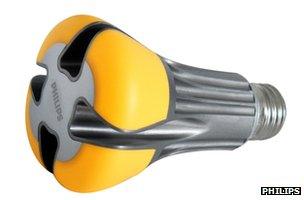LED light bulb to last more than 20 years
- Published

GE used a special cooling mechanism called an active "synthetic jet" to prevent overheating
Light bulbs that are said to last for more than two decades while consuming very little energy may go on sale later this year.
US firm General Electric, Dutch company Philips and Sylvania all showcased their products at the Light Fair industry conference in Las Vegas.
Using light-emitting diodes (LEDs) instead of filaments, the bulbs are meant to produce as much light as a 100-watt incandescent alternative.
However, LEDs are not usually cheap.
In April, Philips introduced its LPrize LED that will cost $60 (£37) - but consumes only 9.7 watts while giving off the same amount of light as a 60-watt incandescent lamp.
The company has arranged discounts with shops that will sell the bulb priced at around $20 (£12).
The new EnduraLED from Philips looks similar, but is said to be equivalent to a 100-watt incandescent bulb while consuming only a quarter of the energy.
Both Philips and Sylvania said their products are due to appear in stores later this year, while GE plans to sell its bulb early next year. The firm currently sells a 9-watt LED bulb that is made to replace a 40-watt incandescent, for about $50 (£31).
All three bulbs are meant to last more than 20 years, if used about three hours per day.
Saving energy
In 2011, the UK's Energy Saving Trust (EST) <link> <caption>carried out a study</caption> <url href="http://www.energysavingtrust.org.uk/Publications2/Energy-efficiency/Lit-Up-an-LED-lighting-field-trial" platform="highweb"/> </link> , measuring the performance of more than 4,250 LED light fittings installed at 35 sites around the UK.
The authors of the report claim the technology can deliver huge energy savings, reduce costs and makes residents feel safer.
"LEDs promise to be the way forward for the whole sector," explained James Russill, EST's technical development manager, in an earlier interview with the BBC.
"There are so many benefits: they can be smaller, brighter; it is one of those rare technologies where the trial has shown it performs better than the lighting systems it is replacing but, at the same time, uses less energy."
Mr Russill said LED light bulbs are more efficient than traditional, incandescent ones because there is less energy loss through heat.
Traditional light bulbs pass electricity through a filament, which results in energy being released as both heat and light, leading to a lot of heat being wasted.
But LEDs are made from a semiconductor material, and are able to emit much more light for the same amount of electricity.
"LEDs are the most efficient light source currently available, and are increasingly used in domestic, commercial and automotive applications," said Mr Russill.
"They can last tens of thousands of hours compared to 1,000 hours for typical incandescent lamps.
"This is due to the use of solid state technology - they have no moving parts, no glass and no filament breakage."
The ongoing results of tests currently underway by the EST show that "lifetimes of more than 15 years are expected to be achieved", he added.
LED challenges
One of the main challenges faced by LED lighting manufacturers is dealing with waste heat produced by the bulb.
Although a lot less energy is wasted through heat than in the case of a traditional light bulb, some heat loss still occurs.
So that the intense heat does not degrade the long life promised by the companies, the lamps need some kind of a cooling mechanism.

It is expected for the new Philips LED light bulb to cost even more than LPrize LED, which costs £37
GE, for example, uses what is called an active "synthetic jet" technology that produces an air flow inside the lamp, pulling the hot air out and creating a cooling air current.
Another obstacle used to be omnidirectional light - making the bulb give off light in all directions.
That is why in the past, LEDs were mostly used for spotlights and flashlights.
But now that this problem has been solved, they have to compete with other products used for general lighting, such as omnidirectional compact fluorescent lights and halogens.
Compact fluorescent lights are almost as energy efficient as LEDs, but cost a lot less.
Production of 100-watt bulbs has stopped in the US and Europe, while production of 60-watt bulbs has been stopped in Europe and is being phased out in the US.
- Published22 April 2012
- Published16 December 2011
- Published19 February 2012
- Published22 December 2011